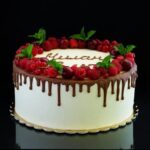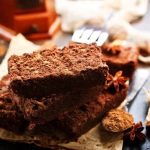Are you looking to add a touch of elegance and creativity to your cakes? Learn how to make a decorative cake stencil and elevate your baking game with unique designs. Cake stenciling is a fun and versatile technique that allows you to customize your desserts with intricate patterns and designs. Whether you’re a seasoned baker or just starting out, creating your own stencils can be a rewarding and satisfying process.
To embark on your cake stenciling journey, it’s essential to understand the basics of this art form. From selecting the right materials to mastering application techniques, each step plays a crucial role in achieving professional-looking results. By familiarizing yourself with the fundamentals of cake stenciling, you’ll be able to unleash your creativity and transform simple cakes into stunning works of edible art.
In this comprehensive guide, we will walk you through the process of designing and using your own cake stencil. From choosing the perfect pattern to troubleshooting common issues, we’ve got you covered every step of the way. So, roll up your sleeves, gather your supplies, and get ready to create show-stopping cakes that will impress your family and friends. With dedication and practice, you’ll soon be on your way to becoming a master of decorative cake stenciling.
Materials Needed for Making Cake Stencils
When it comes to making decorative cake stencils, having the right materials is essential for achieving a professional finish. Here is a list of the basic supplies you will need to create your own customized stencil patterns:
- Stencil material: You can choose from a variety of options such as food-safe plastic, acetate sheets, or even heavy-duty parchment paper.
- Craft knife or scissors: These tools will allow you to precisely cut out your stencil design.
- Self-healing cutting mat: This will protect your work surface and help you make accurate cuts when creating intricate designs.
- Pencil or marker: Use this to sketch out your design on the stencil material before cutting it out.
Now that you have gathered all the necessary materials, here is a step-by-step guide on how to make a decorative cake stencil:
- Start by sketching out your desired design on the stencil material with a pencil or marker.
- Carefully cut out the design using a craft knife or scissors, making sure to follow the lines accurately.
- Once you have cut out the entire pattern, gently clean up any rough edges with sandpaper or a nail file for a smooth finish.
By following these simple steps and using quality materials, you can create beautiful and unique stencils to elevate the appearance of your cakes. Experiment with different designs and techniques to add a personal touch to your baked creations.
Step-by-Step Guide on Designing Your Own Stencil Pattern
Cake stenciling is a fun and creative way to add decorative elements to your baked goods. Designing your own stencil pattern allows you to customize your cakes and showcase your unique style. In this section, we will provide you with a step-by-step guide on how to create your own cake stencil design.
To make a decorative cake stencil, you will need the following materials:
- Cardstock or acetate sheet
- X-Acto knife or craft cutting tool
- Pencil
- Printed design template or drawing skills
- Painter’s tape
Here is a simple guide on designing your own stencil pattern:
- Start by choosing a design for your stencil. This could be a geometric pattern, floral motif, or any other design that speaks to you.
- Transfer the design onto the cardstock or acetate sheet using a pencil. Make sure the lines are clear and precise.
- Using an X-Acto knife or craft cutting tool, carefully cut out the negative space of the design. Take your time and make precise cuts for best results.
With these simple steps, you can create a beautiful stencil that will elevate the look of your cakes. Experiment with different designs and patterns to find what works best for your baking projects. Get creative and have fun with this DIY approach to cake decorating.
Tips for Choosing the Right Stencil for Your Cake
Choosing the right stencil for your cake can make a significant difference in the final look of your creation. When it comes to selecting a cake stencil, there are a few factors to consider. Firstly, think about the theme or design of your cake – whether you want something floral, geometric, abstract, or specific to an occasion like birthdays or weddings. This will help you narrow down your options when browsing through stencil designs.
Another important aspect to keep in mind is the size of the stencil in relation to the size of your cake. A stencil that is too small may get lost on a larger cake, while one that is too big might overwhelm a smaller cake. It’s essential to choose a stencil that complements the size and shape of your cake for a balanced and visually appealing result.
Consider the materials used in the stencil as well. Stencils can be made from various materials such as plastic, metal, or even edible sheets for cakes. Depending on the desired effect and level of detail you want to achieve, different materials may offer better results. Plastic stencils are durable and easy to clean, while metal stencils can create more intricate patterns. Edible sheets provide a seamless finish but may be limited in design options.
| Factors to Consider | Details |
|---|---|
| Theme or Design | Choose based on floral, geometric, abstract, or specific occasion themes. |
| Size | Consider how it fits on your cake – not too small or too large. |
| Materials | Plastic for durability, metal for intricate details, edible sheets for smooth finish. |
By taking these factors into account when choosing a stencil for your cake decorating project, you can ensure that the design complements your overall vision and adds an extra special touch to your creation. Whether you opt for a classic pattern or a modern motif, selecting the right stencil is key to achieving professional-looking results that will impress anyone who sees (and tastes) your beautifully decorated cake.
Preparing Your Cake for Stenciling
Before you start using a decorative cake stencil on your delicious creation, it is essential to prepare the cake properly. The first step in preparing your cake for stenciling is to ensure that it has completely cooled down. Decorating a warm cake can lead to smudging and unwanted texture on the surface, so it is best to let it cool for at least an hour before proceeding.
Once your cake has cooled, you will need to level the top with a serrated knife or a cake leveler. This step ensures that the surface of your cake is even, providing a smooth canvas for the stencil design. Additionally, you can choose to brush away any loose crumbs with a pastry brush to create a clean base for stenciling.
To prevent the stencil from sticking to the icing or fondant on your cake, dusting the surface with powdered sugar or cornstarch is crucial. Lightly sprinkle either of these ingredients over the area where you plan to apply the stencil. This simple trick will allow you to lift the stencil easily without damaging the design or the surface of your cake.
| Important Steps | Details |
|---|---|
| Cooling | Allow your cake to cool completely before starting. |
| Leveling | Use a knife or leveler to even out the top of your cake. |
| Dusting | Sprinkle powdered sugar or cornstarch on the surface for easy stencil application. |
Applying the Stencil
Stencil painting is a fun and creative way to add intricate designs and patterns to your cakes. By using a homemade decorative cake stencil, you can achieve professional-looking results without having to invest in expensive equipment. In this section, we will delve into the techniques for applying the stencil onto your cake for a clean and flawless finish.
Choosing the Right Stencil Placement
Before applying the stencil to your cake, it’s important to decide on the placement of the design. You can place the stencil directly on top of the cake or along the sides for a unique look. Keep in mind that different placements may require varying techniques when adding color through the stencil.
Securing the Stencil in Place
Once you have determined where you want the design to be placed, make sure to secure the stencil firmly on the cake surface. You can use edible glue or even a light mist of water to ensure that the stencil stays in place throughout the painting process. This step is crucial in preventing any smudging or bleeding of colors.
Applying Color With Precision
When it comes to adding color through the stencil, it’s essential to use a light hand and work slowly for a clean and professional finish. You can use an airbrush gun, food coloring spray, or even a small brush to carefully apply color within the openings of the stencil. Make sure to remove excess color before lifting off the stencil to avoid any smudges or blurring of lines.
By following these techniques for applying a decorative cake stencil, you can create stunning and intricate designs on your cakes with ease. Experiment with different colors, patterns, and placements to showcase your creativity and impress your guests at any special occasion.
Adding Color and Decorative Elements to Your Stenciled Cake
After successfully applying the stencil to your cake, the next step is to add color and decorative elements to enhance the design. There are various ways in which you can do this, depending on your preference and the overall look you want to achieve.
One popular method is using edible dust or food coloring to fill in the stencil design. You can use a soft brush or airbrush to gently apply the color, making sure to stay within the lines of the stencil for a neat finish.
Another option is to use icing or frosting to add dimension and texture to your stenciled cake. This can be done by spreading a thin layer of colored icing over the stencil design and then carefully lifting off the stencil to reveal the pattern.
You can also use piping bags with different tips to create intricate details and borders around the stencil design. Experimenting with different colors and techniques will allow you to customize your stenciled cake according to your personal style.
In addition to color, consider incorporating other decorative elements such as edible pearls, sprinkles, or edible flowers to further embellish your stenciled cake. These additions can add visual interest and make your cake even more special for any occasion.
Remember that practicing before working on your final cake can help you perfect your technique and ensure a stunning result. With creativity and attention to detail, you can turn a simple stenciled design into a work of art that will impress your friends and family.
Troubleshooting Common Issues When Using a Cake Stencil
Inconsistent Results
One common issue when using a cake stencil is achieving inconsistent results across the surface of your cake. This can occur due to uneven pressure applied while stenciling or improper alignment of the stencil on the cake. To avoid this problem, make sure to use even and gentle pressure when applying the stencil. You can also secure the stencil in place using tape or magnets to ensure it stays in position while you work.
Bleeding of Colors
Another common issue that may arise when using a cake stencil is the bleeding of colors underneath the stencil design. This can happen if the icing on your cake is too wet or if you apply too much color at once.
To prevent bleeding, make sure to allow your icing to set slightly before stenciling and use a light touch when adding color. You can also try dusting some powdered sugar over the stencil before applying color to absorb excess moisture.
Tearing or Smudging of Design
If you notice tearing or smudging of your stencil design as you remove it from the cake, this could be due to several factors such as using a delicate stencil material or not allowing enough time for the icing to set. To avoid this issue, choose a sturdy and food-safe stencil material like acetate or plastic sheets.
Additionally, wait for the icing to form a crust before removing the stencil gently to prevent any damage to your design. With these tips in mind, you can troubleshoot common issues and create flawless stenciled cakes every time.
Conclusion
In conclusion, mastering the art of making decorative cake stencils opens up a world of endless possibilities for creativity and personalization in your baking projects. By following the step-by-step guide outlined in this article, you can design and create unique stencil patterns that will elevate the look of your cakes to new heights. From simple and elegant designs to intricate and elaborate patterns, there is no limit to what you can achieve with homemade cake stencils.
By understanding the basics of cake stenciling, gathering the necessary materials, and carefully selecting the right stencil for your cake, you are on your way to creating stunning works of edible art that will impress your friends, family, or clients. Remember to take extra care in preparing your cake for stenciling and applying the stencil with precision using the recommended techniques for a clean and professional finish.
With practice and persistence, you will soon be able to add color and decorative elements to your stenciled cakes with confidence and flair.
As you continue to refine your skills in using cake stencils, do not be discouraged by any common issues that may arise during the process. Instead, use them as learning opportunities to improve and innovate in your designs.
Whether you are a seasoned baker looking to try something new or a beginner eager to explore the world of cake decorating, making decorative cake stencils is a rewarding venture that allows you to showcase your creativity and unique style in every slice of cake you serve. Embrace this creative journey with enthusiasm and enjoy the delightful results that come from adding a personalized touch to your baked creations.
Frequently Asked Questions
How Do You Make a Cake Decorating Stencil?
Making a cake decorating stencil involves selecting a design, transferring it onto a sturdy material like plastic or Mylar, and then cutting it out carefully with an X-acto knife or scissors. The stencil should be cleaned before and after each use to ensure the designs come out clean.
What Material Is Used to Make Cake Stencils?
Cake stencils can be made from various materials, but the most commonly used ones are food-safe plastics like acetate sheets or Mylar. These materials are durable, easy to work with, and allow for intricate designs to be cut out neatly. Additionally, they can be easily washed and reused multiple times.
Can You Make a Cake Stencil With a Cricut?
Yes, it is possible to make a cake stencil with a Cricut machine. By uploading a custom design into the Cricut Design Space software, you can then use the machine to precisely cut out the pattern on stencil material like acetate sheets or Mylar. This method provides accuracy and consistency in creating intricate designs for cake decorating projects.

Welcome to my blog about home and family. This blog is a place where I will share my thoughts, ideas, and experiences related to these important topics. I am a stay-at-home mom with two young children. I hope you enjoy reading it! and may find some helpful tips and ideas that will make your home and family life even better!





